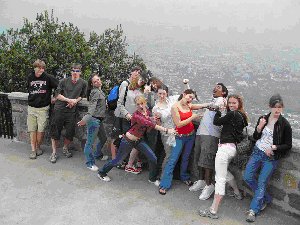Visitors
to Chile Took in
Wonders of a New World, Made Lasting Friendships
By Danny Johnson (April 26, 2005)
Earlier this month, 15 Mason high school
students returned
from the second annual Chile Exchange Program.
The two-week excursion, which included everything from
whitewater
rafting on the river Maipoto making
pottery (or at
least trying) in Pomaire, was especially
unique in
that it allowed the opportunity to learn and know another country and
its
people on a personal level. Other activities included a tour of Santiago,
a visit to the main port of Valparaiso
that included a visit on a Chilean Navy ship, a visit to the beautiful
beach
resorts of Vina del
Mar
and Algarobo, and a visit to Pablo Neruda’s homes.
 |
The 15
students ranged from tenth to twelfth grade, and were
accompanied by three adult chaperones, all faculty members of the high
school.
Ms. deGatica, a Spanish teacher and the
main
facilitator of the exchange, is sister to a teacher in the school that
hosts the
students. It was through this relationship
that the idea for the Chile
exchange arose and was made possible.
The other main overseers of this complex operation
were Ms. Sally
Larish, also a Spanish teacher, and Mr. Brian Dickson, the Renaissance
man who
is in charge of the IB program at the high school.
It should be noted that all three are equally
deserving of recognition and praise for their dedication and sacrifice
to make
the exchange work as flawlessly as it did. |
Following
a tour of Pablo Nerudas's Santiago
home, 12
Masonites express themselves in Cerro San Cristobal,
a mountain area overlooking the city. |
While
in Chile
the Mason students and their guides stayed in the residential housing
of a
predetermined Chilean counterpart family.
This constant and total immersion into the Chilean culture
and society
provided the perfect opportunity to experience another people on a very
intimate
level. The students were hosted by the families from Trewhala’s
School in Santiago.
During the time they were away from their
Chilean brothers
and sisters, the Masonites were guided
through Santiago
and its outlying suburbs and towns on a more tourist-like level. From shopping in small markets in towns even
smaller, to taking a walking tour of downtown Santiago,
the students were shown both the mainstream and downstream currents of
Chilean
culture. Every drive, every walk, every
time one opened one’s eyes, they were blessed with the prospect of
seeing and
understanding a society built and operated literally on the other side
of the
world. No doubt did the real
understanding begin when the trip ended.

